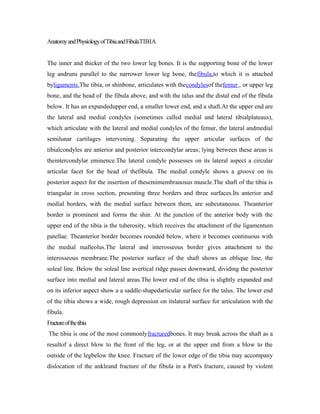
Anatomy and physiology of tibia and fibula tibia
- 1. Anatomy and Physiology of Tibia and FibulaTIBIA The inner and thicker of the two lower leg bones. It is the supporting bone of the lower leg andruns parallel to the narrower lower leg bone, thefibula,to which it is attached byligaments.The tibia, or shinbone, articulates with thecondylesof thefemur , or upper leg bone, and the head of the fibula above, and with the talus and the distal end of the fibula below. It has an expandedupper end, a smaller lower end, and a shaft.At the upper end are the lateral and medial condyles (sometimes called medial and lateral tibialplateaus), which articulate with the lateral and medial condyles of the femur, the lateral andmedial semilunar cartilages intervening. Separating the upper articular surfaces of the tibialcondyles are anterior and posterior intercondylar areas; lying between these areas is theintercondylar eminence.The lateral condyle possesses on its lateral aspect a circular articular facet for the head of thefibula. The medial condyle shows a groove on its posterior aspect for the insertion of thesemimembranosus muscle.The shaft of the tibia is triangular in cross section, presenting three borders and three surfaces.Its anterior and medial borders, with the medial surface between them, are subcutaneous. Theanterior border is prominent and forms the shin. At the junction of the anterior body with the upper end of the tibia is the tuberosity, which receives the attachment of the ligamentum patellae. Theanterior border becomes rounded below, where it becomes continuous with the medial malleolus.The lateral and interosseous border gives attachment to the interosseous membrane.The posterior surface of the shaft shows an oblique line, the soleal line. Below the soleal line avertical ridge passes downward, dividing the posterior surface into medial and lateral areas.The lower end of the tibia is slightly expanded and on its inferior aspect show a a saddle-shapedarticular surface for the talus. The lower end of the tibia shows a wide, rough depression on itslateral surface for articulation with the fibula. Fracture of the tibia The tibia is one of the most commonlyfracturedbones. It may break across the shaft as a resultof a direct blow to the front of the leg, or at the upper end from a blow to the outside of the legbelow the knee. Fracture of the lower edge of the tibia may accompany dislocation of the ankleand fracture of the fibula in a Pott's fracture, caused by violent
- 2. twisting of the ankle. Prolongedrunning or walking on hard ground may cause a stress fracture of the tibia.Some fractures of the shaft heal satisfactorily if the leg is immobilized in a plaster cast, usually for about six to eight weeks. If the bone ends are displaced or unstable, an operation may be neededto fasten them together with a nail or screw.
